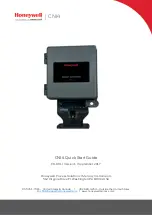
User Manual for
AML Oceanographic’s
Plus
X
24
▪
If the indicator does not light up, the instrument is not operating correctly.
Continue with the remaining troubleshooting items.
•
Allow at least two sample periods for the instrument to detect that it is immersed.
•
Were the sound velocity increment, pressure increment and/or sample rate settings set to
values that could prevent logging?
•
Was the log file name set correctly?
•
Is the connector damaged, dirty, or corroded?
•
If all previous steps fail, reset the instrument. Send an
INIT
command to the instrument to
re-initialize the memory.
•
Note: The
INIT
command will completely erase all settings stored on the instrument.
Instrument generates noisy data:
•
Is the connector damaged, dirty, or corroded?
•
If connected to external power, is there noise on the power supply? Switch-mode power
supplies are common sources of noise.
•
Nearby EMI sources such as electric motors, generators, and transformers can create noise.
If possible, move the instrument and its cables away from the noise source.
•
Are there bubbles on the SV
•Xchange™
sensor or in the
CT•Xchange™ or
C
•Xchange™
sensor?
•
Are the SV
•Xchange™, CT•Xchange™ and C•Xchange™
sensors clean?
•
Is the T•Xchange™ sensor damaged?
•
Is there something nearby affecting the water temperature?
Ni-Cad batteries fail to fully charge:
•
Is the charger connected to the charging cable?
•
Is the power switch on the charger turned on?
•
Is the charger plugged in to a 120 VAC or 240 VAC supply?
•
Allow the charger to charge the batteries until the fast charge indicator light on the charger
turns off.
SeaCast fails to recognize a sensor:
•
Be sure to download the latest version of SeaCast
o
Turbidity•Xchange™
requires SeaCast version 3.0 or greater for full functionality
SV•Xchange
does not match CTD-calculated SV:
•
Owing to the
error associated with each individual sensor and Chen and Millero’s equation
1
,
sound velocity calculated from CTD values will fall within approximately ±0.4 m/s of the
actual value 95% of the time. It is not uncommon to see differences of this size between
directly measured sound velocity and CTD-calculated sound velocity.
1
Chen-
Tung Chen and Frank J. Millero, “Speed of sound in seawater at high pressures,”
The Journal of the Acoustical
Society of America
62, no. 5 (1977): 1129-1135.














































